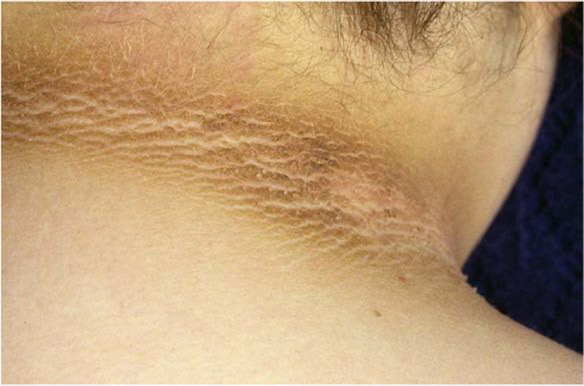What are the skin problems due to Metabolic syndrome?

There is an increasing incidence of obesity with changing lifestyles and food habits calling for a need to focus on its hazards. Obesity is one of the main risks for developing the metabolic syndrome, a term coined not very long ago in 1988 to describe a group of risk factors in over weight individuals. These include hypertension, insulin resistance (high i nsulin levels), abnormal lipid profile and abdominal obesity (increased waist circumference). It is also called syndrome X, insulin-resistant syndrome, dysmetabolic syndrome, and cardiometabolic syndrome. An individual with metabolic syndrome has a greater risk of developing cardiovascular disease and type II diabetes mellitus with all the ill effects of these diseases. There is also risk of developing fatty liver, cholesterol gall stones, asthma, sleep apnea, polycystic ovarian disease, and some forms of cancer.
The prevalence of metabolic syndrome in India is between 18 and 26% with a slightly higher occurrence in South India probably due to genetic predisposition and our lifestyle.
Skin problems are common in those with metabolic syndrome and quite often it is the skin problem that draws attention to the metabolic syndrome. The skin diseases that are associated with metabolic syndrome can be due to the individual components such as obesity and high insulin levels, chronic inflammation, or its associations such as polycystic ovarian disease.
Skin diseases that are commonly seen in obese patients are infections, hyperhidrosis (increased sweating), stretch marks. Skin infections can commonly be due to fungus like candida and dermatophytes (ring worm) or bacterial such as erythrasma. These infections present as reddish patches over folds. While candida can cause burning sensation ring worms itching, erythrasma occurs as asymptomatic patches over folds which is usually ignored by the patients.
High insulin levels cause acanthosis nigricans and skin tags. Acanthosis nigricans occurs as velvety pigmentation over neck and underarms. It is important to see a dermatologist if you have these patches as early life style modifications can prevent development of diabetes and improve the pigmentation as well.
Skin tags are another common finding in obese and insulin resistant patients. They are normal outgrowths of the skin which can be removed by simple cautery or radio frequency.

Another important skin disease associated with the metabolic syndrome is psoriasis. Metabolic syndrome places the body in a chronic inflammatory state where certain inflammatory mediators are constantly released by the fat cells. The same inflammatory mediators are also implicated in the genesis of psoriasis. These markers common to both entities occurring together worsen the clinical picture. Psoriasis is seen as red raised patches with silvery scales. Joint involvement can be very debilitating. It is therefore imperative to evaluate psoriasis patients for metabolic syndrome and its components so that apart from psoriasis treatment specific treatment for abnormal lipids and hypertension can also be started. Lifestyle modification – exercise and balanced diet -remains a very important part of holistic treatment.
Lastly polycystic ovarian syndrome(PCOS), a cause for infertility, is associated with metabolic syndrome and insulin resistance. The common skin conditions associated with PCOS are acne and hirsutism (increased facial hair). Acne and hirsutism cannot just be managed with home remedies or beauty parlors. Professional advice should be sought and it is important to see your doctor to get holistic treatment.
Dr. M. Shraddha MD, DNB, PhD.
Consultant dermatologist
Apollo Hospitals
Greams Road, Chennai
Helios Advanced Skin, Hair & Laser clinic
Pallavaram



